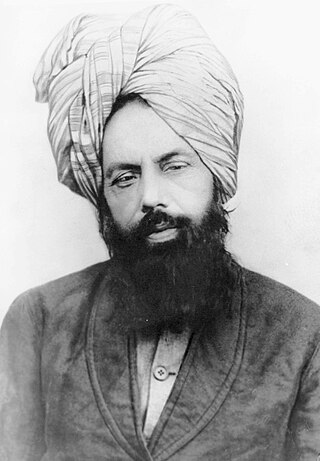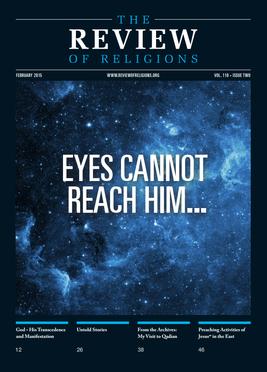
Mirza Ghulam Ahmad was an Indian religious leader and the founder of the Ahmadiyya movement in Islam. He claimed to have been divinely appointed as the promised Messiah and Mahdī—which is the metaphorical second-coming of Jesus (mathīl-iʿIsā), in fulfillment of the Islamic prophecies regarding the end times, as well as the Mujaddid of the 14th Islamic century.

Ahmadiyya considers Jesus (ʿĪsā) as a mortal man, entirely human, and a prophet of God born to the Virgin Mary (Maryam). Jesus is understood to have survived the crucifixion based on the account of the canonical Gospels, the Qurʾān, hadith literature, and revelations to Mirza Ghulam Ahmad. Having delivered his message to the Israelites in Judea, Jesus is understood to have emigrated eastward to escape persecution from Judea and to have further spread his message to the Lost Tribes of Israel. In Ahmadiyya Islam, Jesus is thought to have died a natural death in India. Jesus lived to old age and later died in Srinagar, Kashmir, and his tomb is presently located at the Roza Bal shrine.

The Lahore Ahmadiyya Movement for the Propagation of Islam, is a separatist group within the Ahmadiyya movement that formed in 1914 as a result of ideological and administrative differences following the demise of Hakim Nur-ud-Din, the first Caliph after Mirza Ghulam Ahmad. Members of the Lahore Ahmadiyya movement are referred to by the majority group as ghayr mubāyi'īn and are also known colloquially as Lahori Ahmadis.

The Ahmadiyya Caliphate is a non-political caliphate established on May 27, 1908, following the death of Mirza Ghulam Ahmad, the founder of the Ahmadiyya Muslim Community, who claimed to be a Prophet, a Messenger, the promised Messiah and Mahdi, the expected redeemer awaited by Muslims. It is believed by Ahmadis to be the re-establishment of the Rashidun Caliphate that commenced following the death of the Islamic prophet Muhammad. The caliphs are entitled Khalīfatul Masīh, sometimes simply referred to as Khalifa. The caliph is the elected spiritual and organizational leader of the worldwide Ahmadiyya Muslim Community and is the successor of Ghulam Ahmad. He is believed by the Community to be divinely ordained and is also referred to by its members as Amir al-Mu'minin and Imam Jama'at. The 5th and current Caliph of the Messiah of the Ahmadiyya Community is Mirza Masroor Ahmad.

Ad-Dajjal, otherwise referred to simply as the Dajjal, is an evil figure in Islamic eschatology who will pretend to be the promised Messiah and later claim to be God, appearing before the Day of Judgment according to the Islamic eschatological narrative. The word Dajjal is not mentioned in the Quran, but he is mentioned and described in the Hadith. Corresponding to the Antichrist in Christianity, the Dajjal is said to emerge out in the East, although the specific location varies among the various sources.

Mirza Nasir Ahmad was the third Caliph of the Ahmadiyya Muslim Community from Pakistan. He was elected as the third successor of Mirza Ghulam Ahmad on 8 November 1965, the day after the death of his predecessor and father, Mirza Basheer-ud-Din Mahmood Ahmad.

Mirza Basheer-ud-Din Mahmood Ahmad was the second caliph, leader of the worldwide Ahmadiyya Muslim Community and the eldest son of Mirza Ghulam Ahmad from his second wife, Nusrat Jahan Begum. He was elected as the second successor of Mirza Ghulam Ahmad on 14 March 1914 at the age of 25, the day after the death of his predecessor Hakim Nur-ud-Din.

Hakeem Noor-ud-Din was a close companion of Mirza Ghulam Ahmad, the founder of the Ahmadiyya Movement, and his first successor and first Ahmadiyya caliph since 27 May 1908.

Basharat Ahmad, a member of the Lahore Ahmadiyya Movement, was the author of numerous publications about Islam and the Ahmadiyya movement. He was the father of Naseer Ahmad Faruqui and the father in law of Maulana Mohammad Ali.

Khwaja Kamal-ud-Din was a prominent figure of the early Ahmadiyya movement and the author of numerous works about Islam.

Mirza Ghulam Aḥmad was a religious figure from India, and the founder of the Ahmadiyya Muslim Community. He claimed to be the Mujaddid of the 14th Islamic century, the promised Messiah, and the Mahdi awaited by the Muslims in the end days. He declared that Jesus (Isa) had in fact survived the crucifixion and later died a natural death, after having migrated towards Kashmir and that he had appeared in the likeness of Jesus.
The Mubarak Mosque is a mosque in Qadian and the first Ahmadiyya mosque. It was opened in 1883 by Mirza Ghulam Ahmad, the founder of the Ahmadiyya Movement.

Ahmadiyya, officially the Ahmadiyya Muslim Jama'at (AMJ) is an Islamic messianic movement originating in British India in the late 19th century. It was founded by Mirza Ghulam Ahmad (1835–1908), who said he had been divinely appointed as both the Promised Mahdi and Messiah expected by Muslims to appear towards the end times and bring about, by peaceful means, the final triumph of Islam; as well as to embody, in this capacity, the expected eschatological figure of other major religious traditions. Adherents of the Ahmadiyya—a term adopted expressly in reference to Muhammad's alternative name Ahmad—are known as Ahmadi Muslims or simply Ahmadis.

The Review of Religions is an English-language comparative religious magazine published monthly by the Ahmadiyya Muslim Community. Regularly in print since 1902, it is one of the longest running Islamic periodicals in English. It has been described as the main publication of the Ahmadiyya movement in the language and as a valuable source material for information on the geographical expansion of Ahmadi activity. The magazine was launched by Mirza Ghulam Ahmad with the aim of conveying an accurate understanding of Islamic teachings across the English-speaking world and dispelling misconceptions held against the faith. The articles, however, typically comprise distinctly Ahmadi perspectives. In addition to the English edition published from London, the magazine currently publishes separate quarterly editions in German, French and Spanish.
The Revealed Sermon or was a sermon delivered by Mirza Ghulam Ahmad, the founder of the Ahmadiyya movement, on April 11, 1900 for the festival of Eid ul-Adha. The hour-long sermon, transcribed by Maulvi Nurud Deen and Maulvi Abdul Karim at Ahmad's request, focused on the philosophy of sacrifice. The sermon is considered a divine revelation to Ahmadi Muslims.
Mirza Ghulam Murtaza was an Indian chief and landowner best known for being the father of Mirza Ghulam Ahmad, the founder of the Ahmadiyya movement. He belonged to a family of Mughal nobility that had lost most of its estates to the Sikh Kingdom during the late 18th century and only a fraction of which – including Qadian, the family's ancestral seat – he was able to regain from it.

Promised Messiah Day is commemorated by members of the Ahmadiyya Muslims annually on March 23 which marked the day when Mirza Ghulam Ahmad whom the Ahmadis consider as the Promised Messiah took oath of allegiance from forty members in Ludhiana, Punjab, and initiated the movement.

Chaudhry Fateh Muhammad Sial (1887–1960) was a companion of Mirza Ghulam Ahmad and the first Ahmadi missionary sent from India, under the leadership of Hakeem Noor-ud-Din, the first Khalifa of the Ahmadiyya movement. In 1913, Mirza Basheer-ud-Din Mahmood Ahmad asked for volunteers to serve as Ahmadi missionaries in England. Sial volunteered and travelled to England on June 22, 1913 and arrived the following month. There he served twice as a missionary. He earned an MA in Arabic from the Aligarh Muslim University.

The Ahmadiyya branch in Islam has relationships with a number of other religions. Ahmadiyya consider themselves to be Muslim, but are not regarded as Muslim by mainstream Islam. Mainstream Muslim branches refer to the Ahmadiyya branch by the religious slur Qadiani, and to their beliefs as Qadianism a name based on Qadian, the small town in India's Punjab region where the founder of Ahmadiyya, Mirza Ghulam Ahmad was born.

Al Hakam is an English-language, Islamic newspaper, published weekly by the Ahmadiyya Muslim Jama'at.












